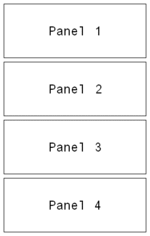Yonkoma

| Part of a series on |
| Animeandmanga |
|---|
 |
|
|
Yonkomamanga(4コマ mạn họa,"four cellmanga"or4-komafor short)is acomic stripformat that generally consists ofgag comic stripswithin fourpanelsof equal size ordered from top to bottom. They also sometimes run right-to-left horizontally or use a hybrid 2×2 style, depending on the layout requirements of the publication in which they appear. Although the wordyonkomacomes fromJapanese,the style also exists outside Japan in otherAsiancountries as well as in theEnglish-speakingmarket, particularly in mid-20th centuryUnited Statesstrips, wherePeanutspopularized the format.[1]
Origin
[edit]Rakuten Kitazawa(who wrote under the name Yasuji Kitazawa) produced the firstyonkomain 1902. EntitledJiji Manga,it was thought to have been influenced by the works ofFrank Arthur Nankivelland ofFrederick Burr Opper.[2]
Structure
[edit]Traditionally,yonkomafollow a structure known askishōtenketsu.This word is a compound formed from the following Japanese kanji characters:
- Ki(Khởi): The first panel forms the basis of the story; it sets the scene.
- Shō(Thừa): The second panel develops upon the foundation of the story laid down in the first panel.
- Ten(転): The third panel is the climax, in which an unforeseen development occurs.
- Ketsu(Kết): The fourth panel is the conclusion, in which the effects of the third panel are seen.[2]
Uses
[edit]These comic strips appear in almost all types of publications in Japan, includingmangamagazines,graphic novels,the comics section ofnewspapers,game magazines, cooking magazines, and so forth. The plot often ends within the four panels; although someserialdevelopment may pass on to future installments, creating a more continuous story. Someyonkomaalso tackle serious topics, though most do so with humor. Some manga occasionally useyonkoma,usually at the end of a chapter or bound volume, as a non-canon joke to complement the story.
See also
[edit]- Jo-ha-kyū– A type of three-act structure found in many traditional Japanese narrative forms
References
[edit]- ^Walker, Brian (2002).The comics: since 1945.New York: Harry N. Abrams, Inc.
- ^abFischer, Carolin."Yonkoma Manga".Mangaka.co.uk.Archived fromthe originalon 2010-07-20.Retrieved2009-10-29.
